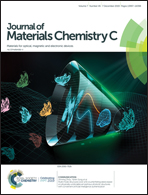A semiconducting organic–inorganic hybrid ([BrCH2CH2N(CH3)3]2+[CuBr4]2−) with switchable dielectric properties derived from an unusual piston-like displacive movement†
Abstract
According to “quasi-spherical theory”, structural modifications of spherical organic components have been found to be useful in obtaining ferroelectric or switchable dielectric organic–inorganic hybrid compounds, but how to tailor the spherical organic components is still unclear. In the current work, a prototype spherical tetramethylammonium cation was modified by replacing one of its H atoms with a CH2Br group, rather than with the widely studied Br atom, to obtain a new organic–inorganic hybrid compound, namely [BrCH2CH2N(CH3)3]2+[CuBr4]2− (BETABCuBr). The structure, phase transition, and dielectric and optical properties of BETABCuBr were carefully characterized. Based on these results, BETABCuBr was indicated to undergo a reversible phase transition at about 356 K, mainly due to a piston-like displacive movement of its Cu atom. The extension of the carbon chain was concluded to lead to a change of the phase transition mechanism from the typical order–disorder movement to an unusual displacive movement. We expect the results of this work to contribute to the exploration of new types of phase transition materials.
![Graphical abstract: A semiconducting organic–inorganic hybrid ([BrCH2CH2N(CH3)3]2+[CuBr4]2−) with switchable dielectric properties derived from an unusual piston-like displacive movement](/en/Image/Get?imageInfo.ImageType=GA&imageInfo.ImageIdentifier.ManuscriptID=C9TC05328J&imageInfo.ImageIdentifier.Year=2019)


 Please wait while we load your content...
Please wait while we load your content...